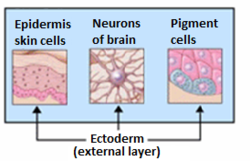
Back أديم ظاهر Arabic Ektoderma Azerbaijani Эктадэрма Byelorussian Ектодерма Bulgarian Ektoderm BS Ectoderma Catalan Ektoderm Czech Ektoderm German Ektodermo Esperanto Ectodermo Spanish
| Ectoderm | |
|---|---|
 Organs derived from ectoderm. | |
 Section through embryonic disk of Vespertilio murinus. | |
| Details | |
| Days | 16 |
| Identifiers | |
| MeSH | D004475 |
| FMA | 69070 |
| Anatomical terminology | |
The ectoderm is one of the three primary germ layers formed in early embryonic development. It is the outermost layer, and is superficial to the mesoderm (the middle layer) and endoderm (the innermost layer).[1] It emerges and originates from the outer layer of germ cells. The word ectoderm comes from the Greek ektos meaning "outside", and derma meaning "skin".[2]
Generally speaking, the ectoderm differentiates to form epithelial and neural tissues (spinal cord, nerves and brain). This includes the skin, linings of the mouth, anus, nostrils, sweat glands, hair and nails,[3] and tooth enamel. Other types of epithelium are derived from the endoderm.[3]
In vertebrate embryos, the ectoderm can be divided into two parts: the dorsal surface ectoderm also known as the external ectoderm, and the neural plate, which invaginates to form the neural tube and neural crest.[4] The surface ectoderm gives rise to most epithelial tissues, and the neural plate gives rise to most neural tissues. For this reason, the neural plate and neural crest are also referred to as the neuroectoderm.
- ^ Langman's Medical Embryology, 11th edition. 2010.
- ^ Gilbert, Scott F. Developmental Biology. 9th ed. Sunderland, MA: Sinauer Associates, 2010: 333-370. Print.
- ^ a b "Derivation of Tissues | SEER Training". training.seer.cancer.gov.
- ^ Marieb, Elaine N.; Hoehn, Katja (2019). Human Anatomy & Physiology. United States of America: Pearson. pp. 146, 482–483, 1102–1106. ISBN 978-0-13-458099-9.
© MMXXIII Rich X Search. We shall prevail. All rights reserved. Rich X Search